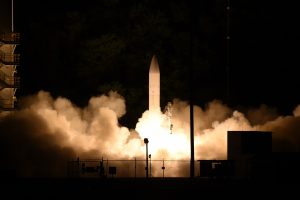The Pentagon announced on October 26 that it was awarding an annual $20 million contract for the next five years to Texas A&M University’s Experimental Engineering Station to start and manage a one-of-a-kind University Consortium for research on hypersonic systems. A Department of Defense (DOD) statement noted that “The Consortium will concentrate on developing hypersonic technologies, investigate efficiencies related to the industrial base, and strengthen partnerships with small and large companies to transition technology and reduce system development timelines.” The University Consortium on Applied Hypersonics (UCAH) will involve 41 institutions, including top universities, across the United States, and is expected to begin operations this fall, the statement noted.
As the Texas A&M statement following the DOD announcement notes, it comes while that university builds the biggest enclosed-tube hypersonic and directed energy testing range in the United States as part of the George H.W. Bush Combat Development Complex whose construction was approved by the university in May this year. The Ballistic Aero-Optics and Materials (BAM) range will be 1 kilometer in length and 2 meters in diameter. BAM will be complemented by Texas A&M’s National Aerothermochemistry and Hypersonics Laboratory and the Aerospace Laboratory for Lasers, ElectroMagnetics and Optics in supporting hypersonics research, the university’s statement also notes.
The DOD’s announcement comes amid its growing interest in fielding hypersonic weapons. Last week, on October 21, U.S. National Security Advisor Robert O’Brien had announced the Trump administration’s plans to equip all U.S. Navy destroyers, as well as newer nuclear-powered attack submarines, with hypersonic missiles. “This capability will be deployed first on our newer Virginia-class submarines and the Zumwalt-class destroyers. Eventually, all three flights of the Arleigh Burke-class destroyers will field this capability,” O’Brien said at the Portsmouth Naval Shipyard in Maine. (For the significance of, and difficulties with, this plan, see the analysis by Robert Farley and Steven Stashwick in these pages.)
Earlier this month, on October 13, U.S. Secretary of Defense Mark Esper had pledged to deploy the first hypersonic missile system with American forces by 2023. The U.S. Army and navy had jointly tested a hypersonic glide body in March this year.
The United States’ push around emerging defense and critical technologies – including hypersonics – comes at a time when U.S. adversaries such as China and Russia are persistently pushing ahead with them. Technology competition has emerged as a crucial driver of U.S defense strategy – something that is likely to be undiminished even if a Biden administration takes over come January. But serious challenges remain in front of the Pentagon when it comes to converting scientific R&D to tangible deployable weapon systems, which goes beyond budgetary allocations challenges.
Through two executive orders in 2019, President Donald Trump had announced artificial intelligence and quantum information science as chief priorities for federal research agencies. The Defense Department’s 2021 budget request included $3.2 billion for research into hypersonics.
But as Mark Lewis, acting deputy under secretary of defense for research and engineering, announcing the launch of UCAH noted, “We often have difficulty transitioning Department-funded basic research from universities through industry to operational applications.” Earlier this year in June, Michele Flournoy, the presumptive Biden nominee for the position of secretary of defense, had called this differential — between proof of concept R&D and full production of new weapons — the “graveyard” of new technologies, urging the Congress to allow the Pentagon to take greater risks while testing new tech emerging from defense research laboratories.
Earlier this month, the Trump administration released a national strategy for critical and emerging technologies, which includes advanced conventional weapons technologies and aero-engine technologies (such as hypersonic systems). Built around two pillars, one of which is promoting “the national security innovation base,” the Trump administration has committed itself to enhance support of civilian R&D in key tech, including through greater funding and collaboration between the government, private sector and academia. The newly-announced UCAH supports this pillar, at least nominally.

































